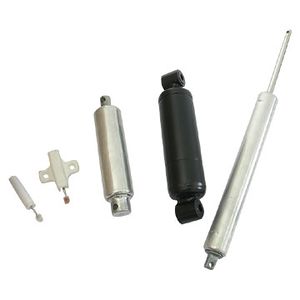Difference between revisions of "Dampers"
| (One intermediate revision by the same user not shown) | |||
| Line 1: | Line 1: | ||
[[Category:Valves]]{{Knoppen}} | [[Category:Valves]]{{Knoppen}} | ||
[[File:DAMPERS.jpg|thumb|right|Dampers]] | |||
'''Damper''' is a valve or plate that stops or regulates the flow of air inside a duct, chimney, VAV box, air handler, or other air handling equipment. A damper may be used to cut off central air conditioning (heating or cooling) to an unused room, or to regulate it for room-by-room temperature and climate control. Its operation can be manual or automatic. Manual dampers are turned by a handle on the outside of a duct. Automatic dampers are used to regulate airflow constantly and are operated by electric or pneumatic motors, in turn controlled by a thermostat or building automation system. Automatic or motorized dampers may also be controlled by a solenoid, and the degree of air-flow calibrated, perhaps according to signals from the thermostat going to the actuator of the damper in order to modulate the flow of air-conditioned air in order to effect climate control. | |||
In a chimney flue, a damper closes off the flue to keep the weather (and birds and other animals) out and warm or cool air in. This is usually done in the summer, but also sometimes in the winter between uses. In some cases, the damper may also be partly closed to help control the rate of combustion. The damper may be accessible only by reaching up into the fireplace by hand or with a woodpoker, or sometimes by a lever or knob that sticks down or out. On a woodburning stove or similar device, it is usually a handle on the vent duct as in an air conditioning system. Forgetting to open a damper before beginning a fire can cause serious smoke damage to the interior of a home, if not a house fire. | |||
Latest revision as of 13:35, 25 January 2013
Damper is a valve or plate that stops or regulates the flow of air inside a duct, chimney, VAV box, air handler, or other air handling equipment. A damper may be used to cut off central air conditioning (heating or cooling) to an unused room, or to regulate it for room-by-room temperature and climate control. Its operation can be manual or automatic. Manual dampers are turned by a handle on the outside of a duct. Automatic dampers are used to regulate airflow constantly and are operated by electric or pneumatic motors, in turn controlled by a thermostat or building automation system. Automatic or motorized dampers may also be controlled by a solenoid, and the degree of air-flow calibrated, perhaps according to signals from the thermostat going to the actuator of the damper in order to modulate the flow of air-conditioned air in order to effect climate control.
In a chimney flue, a damper closes off the flue to keep the weather (and birds and other animals) out and warm or cool air in. This is usually done in the summer, but also sometimes in the winter between uses. In some cases, the damper may also be partly closed to help control the rate of combustion. The damper may be accessible only by reaching up into the fireplace by hand or with a woodpoker, or sometimes by a lever or knob that sticks down or out. On a woodburning stove or similar device, it is usually a handle on the vent duct as in an air conditioning system. Forgetting to open a damper before beginning a fire can cause serious smoke damage to the interior of a home, if not a house fire.
